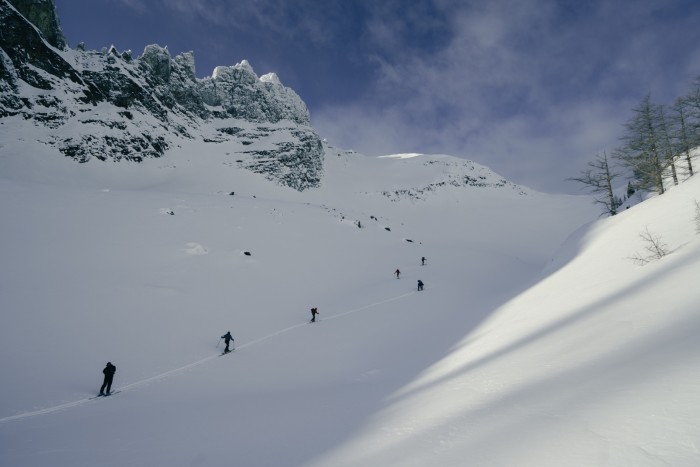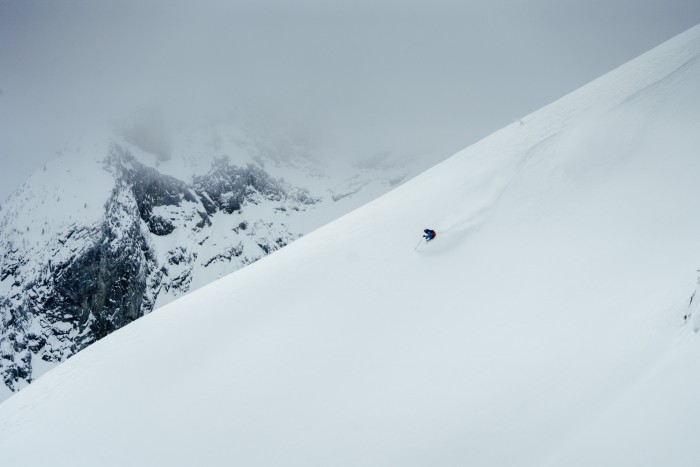The howl of the helicopter’s engines subsided as it climbed away from us, eventually cresting a lofty ridge and disappearing over the horizon. It left us sprawled across a mound of skis, bags and food supplies, clinging on with every available limb like a company of Gore-Tex-clad spider crabs to prevent loose items from being blown away. At last we unclenched, dusted ourselves off and began to take stock of what would be our surroundings for the week.
A handful of log cabins linked by a network of roughly hewn paths were tucked into a clearing, surrounded by old-growth larch and pines, in an otherwise empty valley. Some of the cabins served as sleeping quarters and food storage, and in the centre was the main lodge, Boulder Hut, from whose chimney emerged a wispy pillar of wood smoke. All the roofs were smothered in several feet of snow. Following the smoke upwards with my eyes, I could see that we were close to the top of the dead-end valley, surrounded on three sides by high ridges. To the north lay a frozen lake, beyond which the valley opened to reveal hundreds of peaks stretched as far as the eye could see.

Across the mountains of British Columbia, backcountry huts like this are enjoying a surge in popularity. Unlike most refuges in the European Alps, they aren’t designed as staging posts on the way to climbing a particular peak or completing a multi-day trek, nor are they bases for heli-skiing. Rather, they are places for groups of friends to hole up in the wilderness, usually for a week, climbing the surrounding slopes using skins attached to their skis or splitboards, then riding fresh powder on the way back down.
After a couple of years cooped up by the pandemic, a dozen friends and I had come to Boulder Hut, about 130 miles south-west of Calgary, for what we hoped would be an old-fashioned sort of ski adventure. If first impressions were any indicator, we were off to a promising start: we seemed to have flown back in time and landed in the pages of an unpublished and extremely snowy Hemingway novel.

First impressions were not deceptive. After the 15-minute helicopter flight in from Kimberley, a small town and ski resort, we were well beyond the limits of phone reception; satellite WiFi was available only in case of emergency. Mobile phones were stowed and swiftly forgotten. Guest sleeping quarters were simple and comfortable, if not luxurious — two dorms of six single beds with duvets, cosy wood burners and plenty of space to hang stuff up. An adjacent cabin housed the five staff, including the two guides, Brent Peters and Stephen “Chipie” Windross, and manager Kevin Ostlund.


Over an introductory bowl of soup, Brent explained that we had Boulder Hut’s 15,000-acre “tenure” (government-owned land which the operator pays an annual fee to use) all to ourselves. Here there were no lifts, no snowcats and no helicopters. Just the 12 of us, the air in our lungs, the power in our thighs, the skins on our skis and almost twice as much terrain as Whistler-Blackcomb (North America’s largest lift-served ski area) to explore.
On our first afternoon, after a thorough safety briefing and avalanche transceiver training, we had time for a few hours of skiing to warm up the legs. We zigzagged excitedly up to a gladed zone above the hut called The Roll, where we managed three powdery laps, beginning at the gentle Jelly Roll, getting a little spicier with Sushi Roll and turning up the dial with Rock & Roll.

Boulder Hut was built in 1984 by Art Twomey, a mountaineer and film-maker, and his partner Margie Jamieson. Together they led a lobbying campaign that culminated in the establishment of St Mary’s Alpine Park, which would then grow into the Purcell Wilderness Conservancy — 500,000 acres of protected land in which we now found ourselves. The work they began continues to this day through Wildsight, an NGO whose mission is to protect wilderness areas in British Columbia and raise awareness of issues that threaten them.
Twomey had originally come to BC from the US in the late 1960s, building Ptarmigan Lodge further down the same valley in 1969. He and Jamieson would earn their living from Ptarmigan Tours, an adventure travel outfit centred around backcountry skiing there, but which also took its customers on adventures all over the world, in kayaks, on horseback and on mountain bikes. They eventually moved the ski operation up-valley to Boulder Hut to be closer to the best skiable terrain.
Our visit being in midwinter, we spent a lot of time in the forest, sheltered from the wind and with the trees providing contrast and better visibility on flat-light days. For me, raised on a diet of wide-open slopes above the tree line in the Alps, where tree skiing is often limited, this was an eye-opening experience. On a run called Cardiac we found long and steep pitches between widely spaced old larches. On Bighorn Bash and Stent we bounced over powder-clad “pillows”, which looked like enormous white marshmallows that had fallen out of the pocket of a passing giant. One of our favourite routes back to the hut at the end of the day was via Hey Jude and Come Together: a rollercoaster series of picturesque plunging pitches that wound their way down through cliff bands and ice falls.


The number of ski touring lodges has grown steadily since the first batch — including Boulder Hut — opened in the 1980s. Today, 32 outfits (some of which run multiple lodges) exist in British Columbia, together making up the Backcountry Lodges of British Columbia Association (BLBCA). Despite this growth, demand continues to outstrip supply and many of the lodges are now booking out a year or more in advance. Problems with overcrowding — and long lift lines — at North America’s big resorts seems to be fuelling a growing interest in backcountry alternatives, alongside a more general rise in interest in wilderness adventure that took hold during the pandemic lockdowns.
Our days at Boulder Hut followed a consistent pattern. Up early for a hearty breakfast prepared by cook Ann Palmer, after which we’d each make our packed lunches for the day: sandwiches, homemade cakes, fruit and nuts. We’d slip out at dawn, be back by dusk and ease our tired muscles in the wood-fired sauna (extra points for leaping into the powdery snowbanks and shrieking like a macaque). After supper, ferocious games of Perudo and Yahtzee took over the dining table, with the less competitive among us retreating to the cosy mezzanine above to curl up and read. Most nights we were sleeping like logs by the time the clock struck nine.
When the weather gods did grant us clemency, we emerged from the forest and ventured on to the open slopes (known in North America as the “alpine”). I was fascinated to see guides Brent and Chipie at work, conducting assessments of snow stability as we climbed, digging pits, incessantly plunging their poles into the snowpack, using thermometers to check the snow’s temperature at different depths. This I found to be one of the more illuminating elements of a ski-touring trip, in comparison to lift-served off-piste skiing or heli-skiing, where you enjoy more downhill skiing but are less likely to have time to learn about the craft of moving safely in the mountains.
Lead guide Brent was nonetheless ambitious and, like us, was eager to get into some of Boulder Hut’s more committed terrain, of which there was plenty. The high point to our skiing endeavours, in every sense, was summiting Grace Peak, at 2,600m, on top of which there was just enough space for us all to click carefully into our pin-toe touring bindings (a much more delicate operation than stepping into a pair of alpine bindings) and enjoy a fabulous view of the Purcell range, the Selkirks in the west and the Canadian Rockies away to the east. We skied down its splendid north-eastern flank, through creamy powder that had remained protected from the wind, savouring every turn that much more because of how hard it had been earned, and relishing the feeling of having the entire mountain to ourselves.
Details
Matt Carr was a guest of the British Columbia tourist board (hellobc.com) and Boulder Hut (boulderhutadventures.com). A week at Boulder Hut including helicopter transfers, accommodation, full-board and guiding costs from CA$3,670 per person, based on a full lodge of 12 guests
More ski-touring lodges in British Columbia

Easiest access: Callaghan Country’s Journeyman Lodge A dozen miles from Whistler as the crow flies, Journeyman Lodge is much easier to get to than many BC lodges. Guests can walk the eight miles from the nearest road on skis or snowshoes, or there are once-a-day snowmobile transfers. Add in the private rooms, rather than dorms, the creekside sauna and the fact that visitors can come for a couple of nights rather than a whole week, and you have an ideal entry-level option for those looking for a taste of backcountry-lodge life. From CA$268 per person per night, including full-board and luggage transfer, plus a CA$150 reservation fee per room. callaghancountry.com
Most choice: Golden Alpine Holidays Boasting four lodges in adjacent valleys north of Rogers Pass (on the Trans Canada Highway between Revelstoke and Golden), GAH has something for all kinds of backcountry skiers and splitboarders. The area’s distinctive pillows and fluted ridges have featured heavily in various North American ski movie productions over the past decade — if Eric Hjorleifson and Chris Rubens are names that mean anything to you, there’s a good chance you’ll have seen their exploits in these parts. Their newest lodge, Sentry, is also one of the more luxurious options, including comfortable private bedrooms, WiFi and yoga centre. Access is via helicopter from a staging post just off the road near Rogers Pass. A week’s trip, including guiding, catering and helicopter transfers costs from CA$3,250. gah.ca
Most secluded: Mallard Mountain Lodge Accommodating a maximum of six guests, plus a guide and cook, and a 48-mile helicopter flight in, it doesn’t get much more remote than this. Mallard caters to ski tourers of all levels, including newcomers for whom it offers a number of “introduction to alpine touring” weeks. The lodge sources almost all of its power from solar panels and (among other innovative features) uses an incinerator toilet unit. From CA$4,539 per week, including catering, guiding and helicopter transfers, or CA$3,975 self-catered. The helicopter transfers depart from Valemount, about 200 miles north of Kamloops. canadianadventurecompany.com
For more options see: backcountrylodgesofbc.com
Find out about our latest stories first — follow @ftweekend on Twitter
Stay connected with us on social media platform for instant update click here to join our Twitter, & Facebook
We are now on Telegram. Click here to join our channel (@TechiUpdate) and stay updated with the latest Technology headlines.
For all the latest Travel News Click Here
